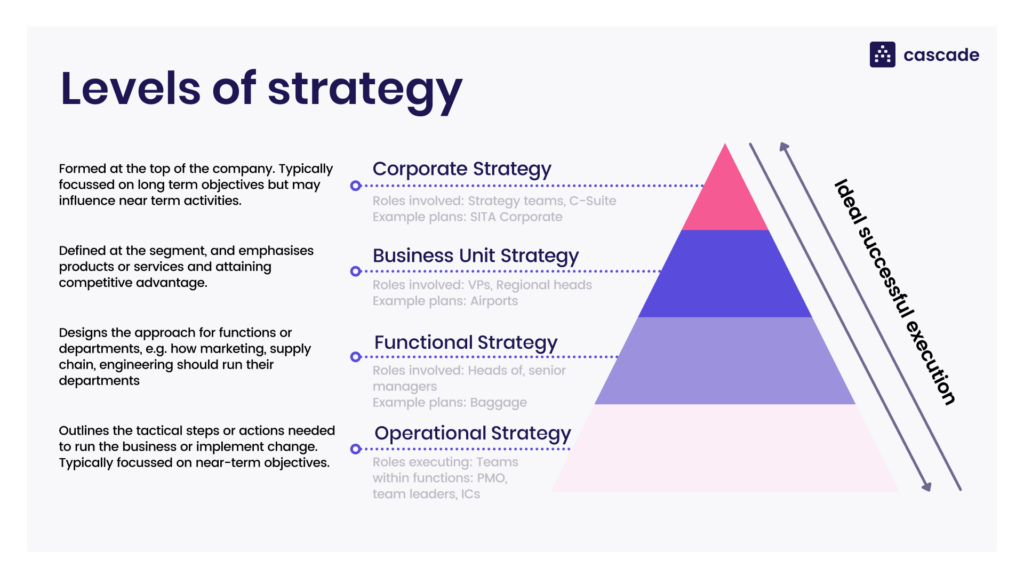“Strategy without tactics is the slowest route to victory. Tactics without strategy is the noise before defeat.”- Sun Tzu
Aligning your vision with practical growth objectives can be challenging. Without a clear plan, your organization can struggle to keep pace with evolving business needs and market pressures. That’s where building a business strategy becomes essential. By focusing on flexible development and a sustainable strategy, you can turn obstacles into opportunities and drive lasting success.
This article will show you how to develop a business strategy that not only accelerates immediate growth but also builds a solid foundation for the future. You’ll also learn what a business strategy truly is and explore detailed steps to build and develop a winning business strategy.
 Image Source: Visioneer IT
Image Source: Visioneer IT
What is a Business Strategy?
A business strategy is a crucial framework that outlines how a company creates value for its customers, employees, and suppliers to gain a competitive advantage. According to Harvard Business School Online, an effective strategy addresses three key questions: how to create value for customers, employees, and through supplier collaboration. Central to this approach is the concept of value creation, which involves understanding the difference between a customer’s willingness to pay and the cost of goods or services. This is visualized using the “value stick” framework, which helps businesses identify opportunities to enhance value for stakeholders. A well-defined business strategy influences critical decisions related to pricing, supplier selection, talent acquisition, and resource allocation, ensuring that the company not only meets its goals but also sustains long-term success.
A well-defined business strategy entails strategic initiatives to gain advantages over competitors. Developing a business framework is essential before you launch your goods, services or products into the marketplace. There are several benefits of planning a business strategy ahead of time:
- Stay agile in a changing market – Quickly respond to industry shifts, customer demands, and competitive trends.
- Capitalize on growth opportunities – Identify new revenue streams, untapped markets, and emerging innovations.
- Build a sustainable competitive advantage – Stand out by using strengths, innovation, and operational efficiency.
- Optimize resources for maximum impact – Ensure budget, time, and workforce are allocated strategically.
- Set clear priorities for growth – Focus efforts on the most valuable initiatives to drive long-term success.
- Track progress and drive continuous improvement – Use key performance indicators (KPIs) to measure success and refine strategies.
Need for a Clear and Focused Business Strategy
A well-defined business strategy is critical for ensuring an organization doesn’t just operate efficiently—but operates with intention, alignment, and long-term viability. In a rapidly shifting market landscape, strategy acts as a compass, enabling businesses to anticipate change rather than merely react to it. It helps leaders make complex trade-offs between competing priorities, such as cost efficiency vs. innovation or short-term gains vs. sustainable growth.
A strong strategy also enables resource optimization by channeling talent, capital, and operational efforts toward the highest-impact areas. Without it, companies risk strategic drift, internal fragmentation, and missed opportunities. A well-defined business strategy provides clarity, direction, and focus, ensuring that every decision aligns with your long-term goals. It also enables you to communicate strategic priorities to employees, stakeholders, and customers. Ultimately, strategy is not just about outperforming rivals—it’s about uniquely positioning the business to deliver superior value over time, even amidst uncertainty.

Steps to Developing a Business Strategy
Successful businesses invest in a planned business strategy before they take their products or services to the marketplace. Today, you can find thousands of businesses that are providing the same services as you do, but standing out from the crowd requires new initiatives and strategies. Developing effective business tactics is complex and requires considerable thought and analysis.
Establish a Vision Anchored in Purpose
Begin by articulating a clear and compelling vision that defines what success looks like for your organization. This vision should resonate across the company and be translated into Specific, Measurable, Achievable, Relevant, and Time-bound (SMART) goals. SMART goals ensure clarity and accountability—each one serving as a checkpoint toward long-term success. With pre-defined goals, you gain clear steps, necessary resources, and measurable milestones along the path. This becomes your roadmap for both achievement and alignment.
A purpose-driven vision not only guides decision-making but also inspires employees and stakeholders by connecting daily operations to broader societal or environmental objectives. It helps reinforce strategic consistency while allowing room for flexible execution.
Conduct Comprehensive Market and Internal Analyses
Before any successful strategy can be created, businesses must know exactly where they stand—both externally and internally. Conduct a thorough market analysis to identify customer expectations, evolving trends, and competitor movements. At the same time, evaluate your organization’s core capabilities and resource gaps. A powerful way to unify both perspectives is through a SWOT analysis—identifying Strengths, Weaknesses, Opportunities, and Threats.
For SaaS and similarly dynamic industries, SWOT analysis is especially crucial. It surfaces areas where your business can double down on competitive strengths while preparing for threats and seizing emerging opportunities. It also forces your team to face organizational blind spots—critical for long-term resilience.
Define and Leverage Competitive Advantage
The first real step in defining a business strategy is understanding what makes you fundamentally different. In a world where many businesses offer similar products or services, identifying your competitive advantage is what shapes your brand identity in the eyes of customers. It might be your pricing model, the way you deliver services, your speed of innovation, or the experience you offer.
This distinct value proposition becomes the linchpin of your strategy—allowing you to compete not just on price, but on strategic differentiation. The goal is to create and sustain a unique position that your competitors can’t easily replicate and your customers can’t easily ignore.
Develop Strategic Initiatives and Action Plans
Once you’ve defined your competitive edge and completed your internal and external analysis, it’s time to build the actual strategy. Your strategic plan should incorporate mission, values, long-term vision, and specific, actionable initiatives that close the gap between current performance and desired outcomes. These initiatives must be backed by clear owners, resource allocation, and milestones that define success.
This stage is about cohesion—tying together all insights into a living, breathing document that informs decision-making and provides operational clarity. Consider including expected challenges and risk mitigation tactics as well.
Align IT Infrastructure with Strategic Goals
A modern strategic plan is incomplete without considering the technology backbone that will support it. As businesses scale, IT must scale with them. This may include migrating to the cloud, updating hardware, and ensuring systems are agile and cost-efficient. For example, many companies that once relied on VMware are now migrating to Proxmox to reduce licensing costs and improve flexibility—98% of VMware users, according to a Q3 2024 survey, are exploring alternatives.
Aligning IT infrastructure with strategic initiatives ensures your systems don’t become bottlenecks, but rather enablers of speed, security, and innovation. Anticipating and preparing for technology shifts is a cost-saving and competitive advantage in itself.
Foster Organizational Alignment and Engagement
Your strategic plan only works if it reaches and activates the people meant to carry it out. Clearly communicating strategic priorities to teams and aligning departmental objectives with the broader vision is essential for momentum. This requires transparency, cross-functional collaboration, and shared ownership.
Involving employees early in the strategy development process enhances engagement and ensures buy-in. Keep teams updated through strategic reviews and dashboards, and celebrate small wins that reinforce collective progress.
Implement Feedback Loops and Monitor Outcomes
Strategy doesn’t end at execution—it evolves. Monitor key performance indicators (KPIs) continuously to evaluate whether your strategic initiatives are moving the needle. This could include customer retention metrics, referral rates, revenue per customer, or even more operational data points depending on your goals.
For example, if you’re aiming to increase referrals from existing clients, create a shared dashboard that tracks referral rates daily or weekly. Share the results with your team—not just to maintain transparency, but to reinforce a culture of accountability and motivation. Evaluate regularly and adapt quickly to external shifts or internal learnings. A strong strategy is agile, data-informed, and continuously refined.

Conclusion
In the end, business strategy isn’t just about drafting a plan—it’s about setting the course for sustained growth, sharper competitiveness, and long-term impact. Whether you’re a startup finding your footing or an established company ready to scale, a well-crafted strategy becomes the backbone of your success. It brings structure to ambition, direction to daily operations, and resilience in the face of change. With the right strategic framework, your business won’t just adapt—it will lead, innovate, and thrive.
Sandeep Kashyap is a guest contributor to the Leadership Circle blog.
Author Bio:
Meet Sandeep Kashyap, the CEO of ProofHub, who is transforming project management and team collaboration with his innovative solutions. With an unwavering passion for leading his team to success, Sandeep’s mantra is simple – “keep growing, don’t stop”. When Sandeep is not busy at work, he loves to explore new destinations and challenge himself with trekking adventures.






I completely agree that building a business strategy isn’t just about short-term wins. It’s about laying a foundation for long-term success. Especially in today’s ever-evolving market, flexibility in strategy is key to staying ahead of the competition.
“Thanks for breaking this down so clearly! If anyone’s interested, I’ve written a complementary perspective on this subject that might add additional value.”
This topic deserves more attention, and I appreciate how well it’s presented here! I’ve written about similar concerns on my website.
I’ll definitely be using the tips you shared here.